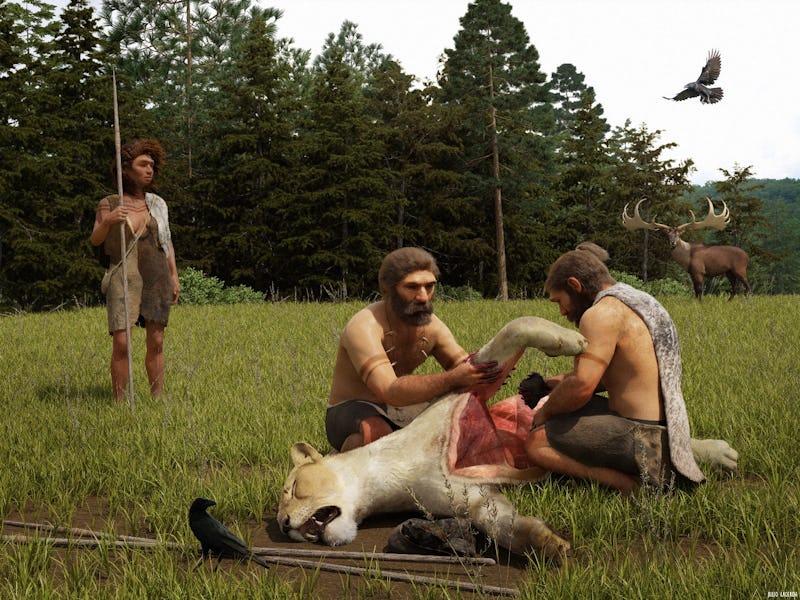Neanderthals Chowed Down On Big Cats, Ancient Lion Remains Show
Our hominid cousins were some pretty ballsy hunters.

From about 2.5 million to 11,700 years ago, big cats like the cave lion roamed all corners of the globe. Much like early humans, early lions migrated out of Africa to neighboring Asia and Europe, eventually crossing the now-extinct land bridge of Beringia, likely for the rich hunting grounds of North America.
As a visibly powerful apex predator, it’s no wonder cave lions were revered by our hominid ancestors, as evidenced in cave art, the Löwenmensch (or Lion Man) figurine carved from mammoth ivory, and ornaments sporting razor-sharp canines. But early humans like Neanderthals may have held a more fraught relationship with the massive felines, one at times bordering antagonism dictated by survival rather than awe.
In a study published Thursday in the journal Scientific Reports, researchers believe they have uncovered direct evidence of Neanderthals actively hunting cave lions. Examining skeletal remains of specimens collected from two archaeological sites in Germany, it appears the early hominids used wooden spears to bring down cave lions, skinning and butchering the carcasses for their pelts and meat.
These findings add more weight to the idea cave lions had a lot more competition than expected at the top of the food chain, which, along with the faunal and environmental changes at the end of the last ice age, led to their demise 14,000 years ago.
Have spear — will hunt and accessorize
While there’s been archaeological evidence gathered from caves across Europe pointing to potential lion hunting, such as pelts and bits of butcher-marked bone, the study’s authors write that “it remains unclear how other human species interacted with this apex predator, beyond interspecies competition.”
To unravel the mystery of the Neanderthal-cave lion relationship, the researchers examined the skeletal remains of a 48,000-year-old male cave lion first excavated some decades ago in Siegsdorf, Germany, and the toe bones of three adult cave lions found in Einhorn Cave (Unicorn Cave in English) up north in Germany’s Harz Mountains.
The cave lion remains from Siegsdorf are displayed alongside a reproduction of a wooden spear similar to those used by
When the Siegsdorf cave lion was first found, archaeologists noticed several cut marks on its bones, suggesting that the body had been butchered after death. But reexamining the skeleton, the researchers discovered, on the third rib close to where it joined with the spine, a divot in the bone akin to a puncture. Such an injury appeared consistent with wooden spears used by Neanderthals at the time based on other archaeological evidence and a ballistics reconstruction.
Given the angle, the researchers believe that as the Siegsdorf cave lion basked in the sun — as modern-day lions do — a group of hunters ambushed the unsuspecting beast, stabbing it from behind and through its lower abdomen while it lay on its right side. The idea isn’t too far-fetched as hunters from 50,000 to 12,000 years ago — called the Upper Paleolithic — used this approach to hunt hibernating cave bears, the researchers say in the paper.
However, another theory is that the fatal blow was delivered while the cave lion was disadvantaged in some way, maybe from exhaustion or sustaining blows during its fight with the hunters or because it was old and unable to defend itself.
It’s unclear whether there was a social value in hunting the lion, that intentionally going after a big prey animal meant a bump in social status for daring Neanderthals. Even if so, our hominid cousins existed in hunter-gatherer societies, so the kill was in part opportunistic. Cave lion on the menu might not seem appetizing to us in the modern day, but archaeological findings from other sites dating back to the middle of the Pleistocene — an epoch lasting between nearly three million to 11,700 years ago — suggests early hominids went ham on big carnivores.
As for the cave lion toe bones excavated from Einhorn Cave in 2019 and dating back to around 55,000 to 45,000 years ago, they bore the characteristic cut marks from butchering. It’s not clear whether the animals had been killed by hunters or found dead by foragers. But what is clear is that big cats’ thick fur was skinned carefully to ensure the claws — the very ends of the toe bone not present — remained preserved within the fur. The lions' pelts were likely prized possessions, potentially signifying social status but also practicality: the fur undoubtedly kept its owner warm during the cold spells both as clothing and bedding.
While cave lions eventually went extinct around 14,000 years ago, at the end of the last ice age, it goes to show how the strength and majesty of these powerful creatures have captivated civilizations throughout human history. One caveat: Big cats are probably not going to be back on the menu any time soon.
This article was originally published on